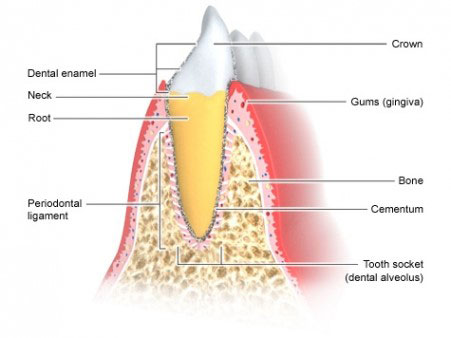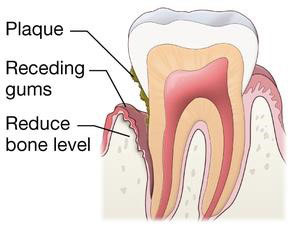What is Periodontitis?
 We have all heard the phrase “gum disease”, and chances are if you’ve been to the dentist the concept of gum health has been brought to your attention, but do you know what periodontitis, or gum disease, really is?
We have all heard the phrase “gum disease”, and chances are if you’ve been to the dentist the concept of gum health has been brought to your attention, but do you know what periodontitis, or gum disease, really is?
When visiting the dentist, looking at the crown (the white part above the gums) is often all people assume the dentist is examining and the hygienist is cleaning. But that is only a small part of what we do. The periodontium, or the gums and bone surrounding the teeth, is an integral part of oral health. We check the periodontium every visit and it is vital to have “healthy gums” for a healthy mouth. While it is common to hear the phrase “gum disease”, often times that is not exactly what is going on in a patient’s mouth. Gum disease, or gingivitis, is a superficial inflammation of the gums. Periodontitis can look a lot like gingivitis to the patient but needs to be taken more seriously.
Periodontitis is Inflammation
 Periodontitis is an inflammatory disease of the gums and bone surrounding the teeth. Our teeth are held in place by bone connected to the tooth through the periodontal ligament, which also offers some “cushion” for when we bite down. Then, the gums or soft tissue are on top of the bone and surround the tooth. Periodontitis or periodontal disease occurs when plaque or calculus builds up under the gums, causing an infection. An immune response occurs, causing inflammation of the gums and bone resorption. Left untreated, periodontitis can result in tooth loss and further infection.
Periodontitis is an inflammatory disease of the gums and bone surrounding the teeth. Our teeth are held in place by bone connected to the tooth through the periodontal ligament, which also offers some “cushion” for when we bite down. Then, the gums or soft tissue are on top of the bone and surround the tooth. Periodontitis or periodontal disease occurs when plaque or calculus builds up under the gums, causing an infection. An immune response occurs, causing inflammation of the gums and bone resorption. Left untreated, periodontitis can result in tooth loss and further infection.
Periodontitis Needs to Be Addressed
There are several ways we diagnose periodontal disease. With x-rays, we are able to see the bone levels in between the teeth and see if there is any bone loss or resorption, and can sometimes even see calculus, or hardened tartar buildup between the teeth on x-rays. Along with x-rays, the most comprehensive way we measure gum and periodontal health is with “Perio Charting”. When your hygienist reads off numbers (111, 312, 323, etc) or charts them, he or she is actually measuring gum levels. A measuring tool is used to see how far underneath the visible gum level the soft tissue actually attaches to the tooth in millimeters. Because the bone level is right under where the attached tissue is, this tells the hygienist and dentist how much bone level is lost. The look of the gums and bleeding points are all recorded during perio charting for a comprehensive diagnosis.
Periodontitis needs to be addressed because it is an infection in your mouth. Just like an infection anywhere else in your body, it needs to be treated. However, periodontitis is unique in the fact that the treatment is not oral antibiotics. The infection is caused directly by the bacteria or plaque built up on the surface of the tooth (see picture below), and without removal of that build up the infection will not improve.
 The inflammation associated with periodontal disease affects whole body health as well, and has been proven to be linked with diabetes, dementia, heart disease, and many others.
The inflammation associated with periodontal disease affects whole body health as well, and has been proven to be linked with diabetes, dementia, heart disease, and many others.
Periodontitis is Treatable
Periodontitis can be resolved with a dental cleaning, or debridement, by a dental hygienist. Based on the perio chart and x-rays, your dental hygienist and dentist will make a comprehensive treatment plan catered specifically to your oral health. Regular dental cleanings are imperative to good oral health, along with taking care of your teeth at home through proper brushing and flossing. The removal of the bacterial infection and buildup causing periodontitis will arrest the disease and get you back on track to a healthy smile.
Call us today to schedule an appointment to address any oral health concerns you have. At Spokane Dental, we provide thorough and compassionate care and strive to help our patients achieve the healthy smile they want.

